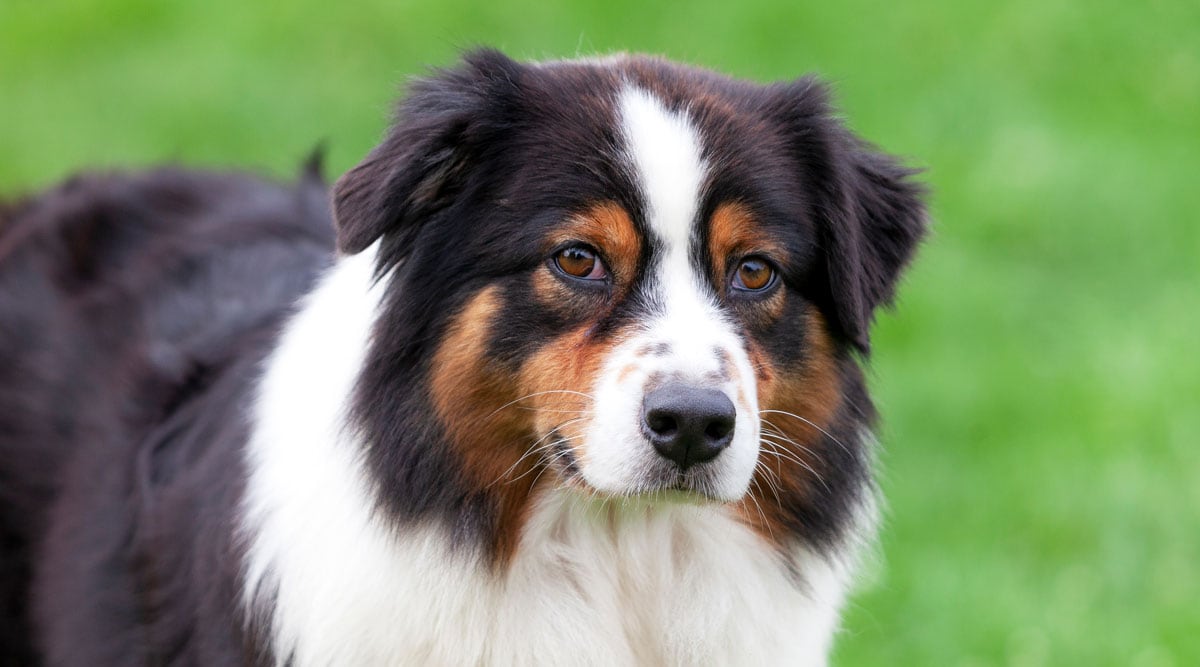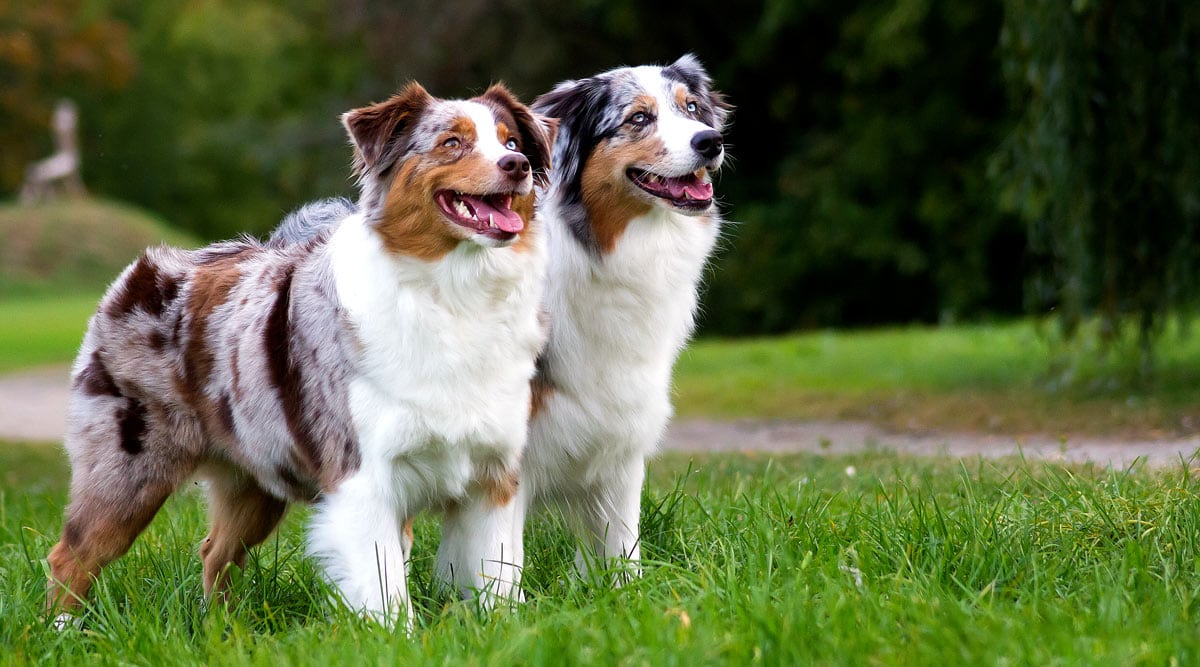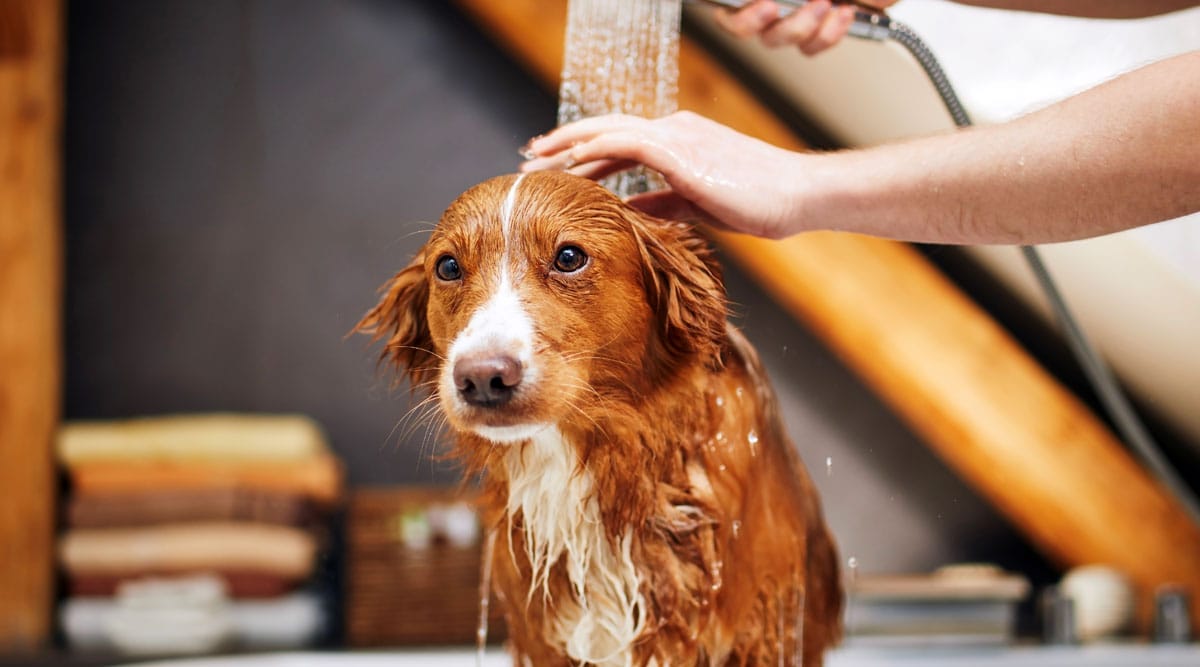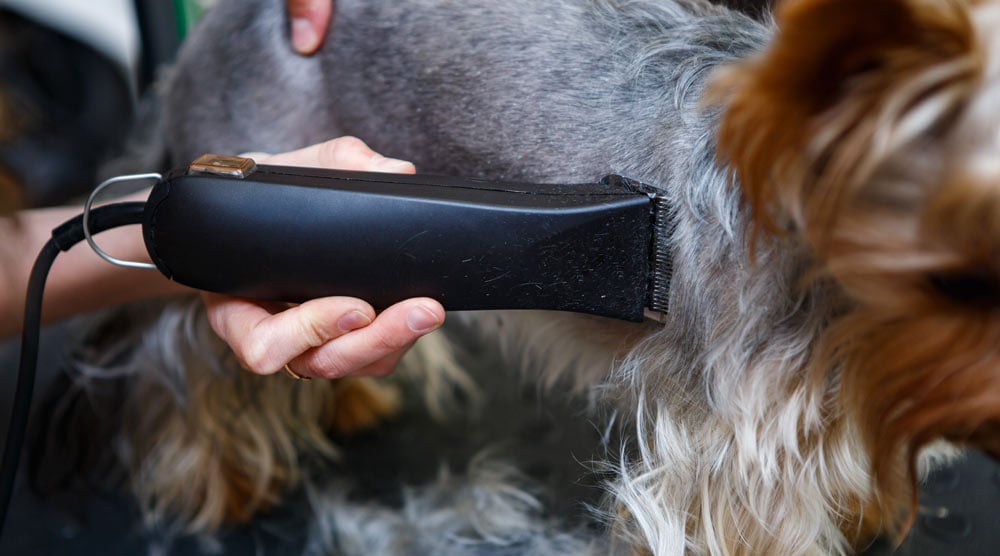The quick answer is that Australian Shepherds do shed their hair. They’re not the heaviest shedding dog breed, but they have a thick undercoat and long topcoat that both moult throughout the year. They also go through bi-annual “coat blows” where large amounts of undercoat sheds in a relatively short period.
There are some things you can do to reduce Aussie shedding though. In this article, I’ll discuss the Australian Shepherd coat, how much it sheds, and how to groom this wonderful breed.
Contents
- The Australian Shepherd Coat
- Do Australian Shepherds Shed?
- When Do Australian Shepherds Shed?
- How Much Do Australian Shepherds Shed?
- What Can Cause Increased Aussie Shedding?
- How to Maintain a Healthy Australian Shepherd Coat
- Tips for Managing Shed Aussie Hair in Your Home
- Frequently Asked Questions
- Summary
The Australian Shepherd Coat
There’s no denying that Australian Shepherds have a beautiful coat. The coat has an attractive feathering around the britches and legs, and a mane-like appearance around the neck.
A key point about Aussies is that they have a double coat consisting of the undercoat and topcoat. Breeds with double coats tend to shed more than those with single coats, such as Poodles
The topcoat is made of longer, silky hairs. It protects the Aussie from dirt, rain, UV rays, and parasites, while also giving the breed its distinctive appearance.
Meanwhile, the undercoat is a thick and dense layer that’s mainly for insulation. It’s vital for helping Aussies cope with both cold and hot weather. The undercoat also varies in thickness depending on the season.
Fun Fact: Did you know that Australian Shepherds aren’t native to Australia? In fact, they’re American-bred descendants of the Pyrenean Shepherd, a breed that needed a thick coat to survive in colder climates.
Do Australian Shepherds Shed?
Yes, Australian Shepherds are moderate shedders.
This isn’t necessarily a bad thing. Shedding is natural and normal for double-coated dogs, as it helps maintain coat health. Even so, I’ve found that the effort needed to clean shed hair in the home is often overlooked when pet parents consider adopting a dog.
Both the undercoat and topcoat of the Aussie shed. Topcoat shedding is fairly consistent throughout the year. Undercoat shedding becomes heavier during the “blow” seasons of Spring and Fall, which is something to keep in mind before choosing this breed.
However, it’s worth noting that Aussies probably won’t shed as much as some other breeds. For example, Golden Retrievers, Huskies, and German Shepherds are all heavier shedders.
When Do Australian Shepherds Shed?
Australian Shepherds shed all year round. So, keeping a broom or vacuum handy is always a good idea!
You’ll notice an increase in shedding during the Spring and Fall though, when Aussies undergo what is referred to as “coat blow.” This bi-annual shedding of the undercoat allows the coat to adapt to the upcoming season
In the Spring, the undercoat sheds in clumps and is replaced by a less dense undercoat. This change keeps the Aussie cool during the warmer months. Come Fall, the process repeats, but this time the undercoat returns to a thicker density for chilly weather.
During these “coat blow” periods, you’ll need to do even more brushing than usual. Many Aussie owners brush their dogs daily to remove the copious amounts of shed undercoat.
How Much Do Australian Shepherds Shed?
We’ve established that Australian Shepherds are moderate shedders. But it’s worth keeping in mind that shedding levels can vary among individual Aussies. Factors such as genetics, environment, climate, and diet can influence how much an Aussie sheds.
Also, it’s important to mention that Aussies have relatively long hairs. So, even though they may shed moderately, the hair they do shed tends to be quite noticeable.
If you’re someone who prefers a dog breed that barely leaves behind any hairs, the Aussie probably isn’t the right choice. However, if you’re prepared to meet their grooming and cleaning requirements, Australian Shepherds can make wonderful companions.
What Can Cause Increased Aussie Shedding?
Have you that your Australian Shepherd is shedding more than normal? While shedding varies naturally during the year, excessive shedding could be a signal that something else is going on.
Heat and Season
Australian Shepherds, like many other breeds, change their undercoats in response to the seasons. These transitions occur in Spring and Fall, and cause increased shedding.
So, if you’re finding more undercoat hairs scattered around your house during these times, your Aussie might just be getting prepared for the upcoming weather changes.
Losing Puppy Coat
At around 4-6 months old, young dogs shed their puppy coat to be replaced by their adult coat. This can lead to a temporary spike in shedding.
Poor Nutrition
Good nutrition is vital to maintaining a healthy coat for an Australian Shepherd. Omega 3 and Omega 6 fatty acids are particularly important nutrients for coat health, but there are many more. A diet lacking these nutrients can result in a dull coat and premature hair loss.
Stress and Anxiety
Stress can lead to excessive shedding in dogs. Changes in routines, new family members, or any other disruption can cause stress in your Aussie.
If you notice increased shedding along with other signs of stress, it’s crucial to consult a vet or a canine behaviorist. Some signs of stress to watch out for include:
- Pacing
- Lip licking
- Yawning
- Cowering or a hunched posture
- Difficulty sleeping or settling
- Increased vocalizations
Skin Conditions (Including Allergies and Mites)
Various skin conditions can cause increased shedding. In many cases, the hair loss is caused by the dog scratching the skin, not the condition itself.
For example, the itching caused by fleas can lead to extensive scratching, damaging the skin and hair. If not addressed, this can result in bald spots. Mites are another parasite that can cause itchy skin, dandruff, and hair loss. Allergies, both environmental and food-based, can also lead to hair loss if your dog has an allergic reaction.
If you spot any signs of skin conditions, contact your vet immediately. The right treatment depends on an accurate diagnosis.
Hormonal Imbalances
Alopecia, the medical term for hair loss, can sometimes be the result of a hormonal imbalance in dogs. Any unusual hair loss should be assessed by a vet, as hormonal issues can indicate underlying health problems.
Note: Aging can trigger hormonal changes. These changes may affect how much your dog sheds.
Other Medical Conditions
Other health conditions, including serious ones like cancer, can cause excessive hair loss. If you find your Aussie shedding more than usual, especially outside of their normal “blow coat” periods, consult your vet. This is not a symptom to ignore.
How to Maintain a Healthy Australian Shepherd Coat
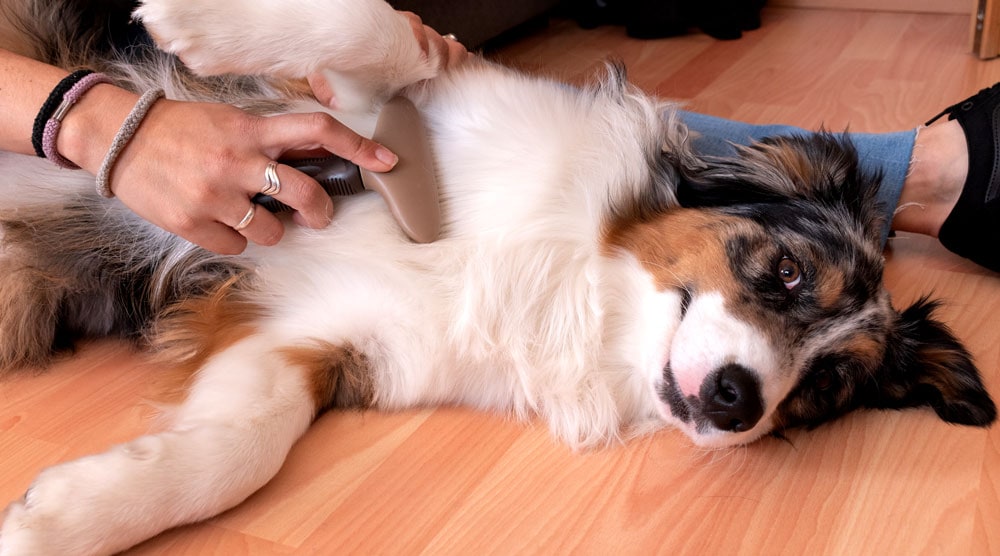
The key to a healthy Aussie coat is regular grooming – particularly brushing. Here are some tips for maintaining an Australian Shepherd’s coat:
- Brushing several times per week is essential for Aussies. Brushing your Aussie’s hair doesn’t just prevent tangles and mats. It also spreads natural oils throughout the coat and promotes new hair growth. You’ll need a variety of brushes for your Aussie to tackle different parts of the coat, including a slicker brush, pin brush, and comb. Don’t skip this step – brushing an Aussie is the most important way to keep their coat healthy.
- Remove tangles with a comb. During your regular brushing sessions, look for any tangles or mats that are starting to form. If possible, remove these gently with a stainless steel comb.
- Don’t bathe your Aussie too frequently. Bathing too often can strip a coat of natural oils and cause skin dryness. It can also affect the coat’s insulating properties. For this reason, you should only bath your Aussie when it’s really necessary (every 2-3 months is usually fine). Of course, if your dog rolls in something smelly or gets very dirty, you may need to bathe them.
- Always use dog shampoo and conditioner. Dogs have a different skin pH to humans, so you should only use canine-specific hair products on your pet. Do not use human conditioners or shampoos. It’s also important to choose gentle shampoos with organic ingredients and no harsh chemicals.
- Discuss omega-3 fatty acid supplements with your vet. Omega-3 is essential for skin and coat health. It’s also linked with joint health and reducing inflammation. However, supplementation is not suitable for all dogs, so make sure you discuss it with your vet first.
- Watch for signs of skin issues. Brushing your dog is a great time to check for any abnormal signs. These could include skin parasites, lumps, patches of fur colour changes, or areas of hair loss. Take your dog to the vet as soon as you notice any potential symptoms of illness.
- Never shave an Aussie. Australian Shepherds have a double coat that’s naturally balanced to provide protection and insulation. If shaved, there is a risk that the coat will never properly grow back. A shaved double coat also loses its insulating properties – not to mention that it will still shed (just shorter hairs).
Tips for Managing Shed Aussie Hair in Your Home
Maintaining a hair-free environment with an Australian Shepherd can be a challenge. There are some steps you can take to keep hair under control though.
Maintain a Regular Brushing Schedule
Brushing is the most effective way to manage your Aussie’s coat and minimise hair in your home. So, if you only do one thing on this list, make it brushing!
Why is brushing so important though?
Regular brushing removes loose hair before it can drop onto your carpet or furniture. You’ll probably be shocked by how much hair you can brush out of your dog’s coat! Brushing also promotes a healthy coat, which can reduce excess shedding.
Aim to brush your Aussie at least twice a week, although this frequency will need to increase during the Fall and Spring coat blows. It’s also advisable to brush your pet outdoors to prevent loose hair from scattering around the house. If you have to brush indoors, vacuum immediately after to clean up the loose hair.
Related Article: Which Are The Best Dog Brushes?
Clean Little And Often
Try to avoid allowing dog hair to accumulate in your home. It can be very hard to get hair back to manageable levels once it’s out of hand, especially when your Aussie is blowing their coat!
I find it easier to perform short, regular daily cleaning sessions to remove the majority of hair. A cordless or handheld vacuum can make this task more convenient.
Wash Your Dog’s Bedding Regularly
Your dog’s bedding can be a hotspot for loose hair and dander. Therefore, it’s crucial to wash an Aussie’s bed cover at least weekly.
I always recommend beds with removable covers for double-coated breeds. It’s much easier to wash a cover than an entire bed.
Consider a Robot Vacuum Cleaner
A robot vacuum cleaner can be a handy tool to manage Aussie hair. These devices can be programmed to clean at specific times, making them perfect for daily maintenance. I like to set mine to come on when I’m out on my morning walk, as this avoids disturbing the dogs.
While robot vacs might not match the power of regular vacuums, their consistent cleaning reduces the need for manual vacuuming.
Have a Continuous Supply of Lint Rollers
Aussie hair gets everywhere – including furniture and clothes. For these surfaces, a lint roller is a convenient option, especially if you need to quickly remove hair.
Frequently Asked Questions
Can You Stop An Aussie From Shedding?
No, you can’t prevent an Australian Shepherd from shedding. Shedding is a natural and important process that maintains the health of their coat.
Are Australian Shepherds a Hypoallergenic Breed?
No, Australian Shepherds are not a hypoallergenic breed. They shed a lot of dander and hair, which can trigger allergic reactions in people with allergies. Remember, no dog breed is entirely hypoallergenic, as all dogs shed some skin dander.
Can Australian Shepherds Be Shaved?
No, you shouldn’t shave an Australian Shepherd. Doing so can permanently damage their double coat, disrupt its insulation properties, and won’t stop the shedding.
Summary
Australian Shepherds are moderate shedders. They also have bi-yearly coat blows, during which their undercoat falls out and is replaced by new hairs.
Maintaining a healthy coat is important for both your dog’s health and keeping shedding to a minimum. Brushing is the key to a healthy Aussie coat, but you should also ensure your pet is getting a nutritionally complete diet.
Do you have any questions about whether Australian Shepherds shed? Please let us know in the comments sections below.
